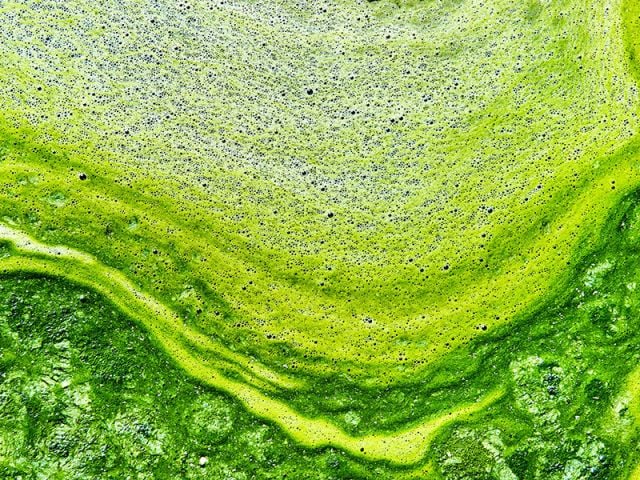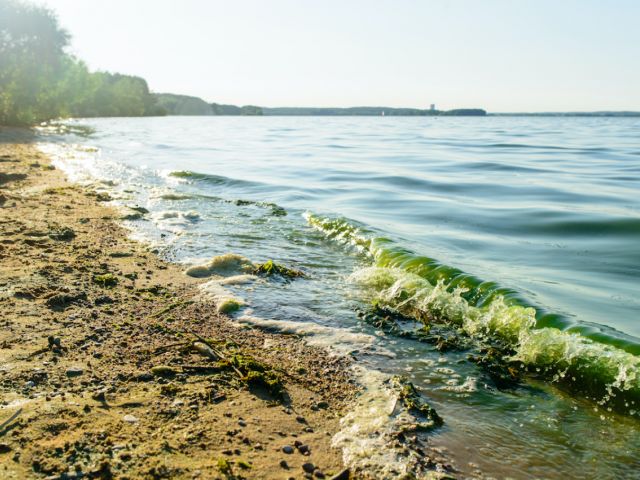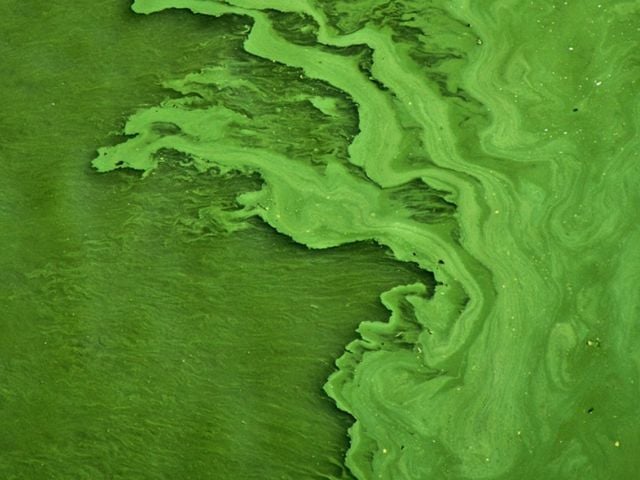
As summer comes to a close, EWG continues to track toxic algae outbreaks across the U.S.
Toxic algae blooms have been on the rise nationwide, polluting lakes, ponds, rivers and other bodies of water and causing beach closures, making people sick and killing household pet and wildlife. Peak algae season is summer, due to sunny weather and warmer water, but blooms can occur any time – and off-season outbreaks have become more common in recent years.
As the climate crisis raises temperatures and increases the frequency of extreme rain events, toxic algae blooms will continue to become even more frequent and ubiquitous. Exposure to toxic algae, which are actually cyanobacteria, can harm both humans and animals.
Here’s what you should know about the potential hazards of toxic algae blooms.
Common short-term symptoms
People become exposed to toxic algae through skin contact, ingestion and even inhalation. They often come in contact with it when swimming or playing in polluted water, though newer research shows toxins can also be airborne. So it can pose a risk to anyone on a beach or walking near the water. In fact, scientists have found toxic algae in the air up to 10 miles away, indicating the threat may be even more widespread than previously thought.
Common short-term signs of exposure range from headaches and skin irritation to fever and vomiting. These symptoms usually begin within a few hours and can last for several days. Inhaling airborne toxins may also lead to inflamed airways and respiratory symptoms.
Not all blue-green algae blooms are toxic, but those that are produce various types of toxins called cyanotoxins, which can produce a range of health effects.
It is impossible to tell whether a bloom is toxic without laboratory tests, so if you see or smell signs of an algae bloom, try to avoid getting in, or near, the water.
Potential long-term risks
Research on the long-term effects of toxic algae exposure is fairly new, but some studies have already documented potential chronic symptoms. Some severe cases have resulted in lasting organ damage, such as acute kidney disease and liver failure.
Emerging research also connects exposure to cyanotoxins with certain neurodegenerative diseases. A link has been found between cyanotoxins and an increased risk of developing Lou Gehrig's disease, the progressive degenerative disease also known as ALS. And studies have also linked cyanotoxin exposure to a higher risk of Alzheimer’s.
Threats to children’s health
Because kids may be more likely to ingest large quantities of water or spend longer in water than adults when swimming, they have a greater risk of dangerous exposure to toxic algae. Symptoms can also be more severe for children, because of their small bodies.
If you think your child has come into contact with toxic algae, or shows unusual or flu-like symptoms after playing in or near an outbreak, rinse them off with water and make sure they drink plenty of water. You may want to also seek medical attention as soon as possible, especially if symptoms are serious or persist.
Increased risk for pets
Toxic algae blooms present a special danger to pets. The risk of severe harm and death is much higher for dogs than for adults – those that swim in water with an algae bloom are more likely than humans to ingest toxins by drinking the water, licking their fur or eating dead animals that have been poisoned.
Special care should be taken to prevent them from playing in or near polluted waters.
Each summer, several dogs are killed by toxic algae exposure. This year, a dog died within several hours of swimming in Austin’s Barking Springs, a canine recreational area of the Barton Springs Creek that tested positive for cyanotoxins.
Harm to ecosystems
Algae outbreaks can be devastating to a marine ecosystem. Thick blooms block sunlight, killing plants and animals that rely on the sun to survive. Algae can clog the gills of fish and shellfish, preventing them from breathing. Dying algae consume theoxygen in water, which can create dead zones where nothing can survive, including microorganisms.
Algae toxins can be ingested by small fish and shellfish. As these fish are consumed by larger animals, they can lead to large fish kills and die-offs.
Decaying algae also releases greenhouse gases like methane, which exacerbate the climate crisis. As the climate crisis worsens, warmer waters and more frequent rain events cause more algae outbreaks, creating a toxic feedback loop.
Preventive measures
Toxic algae blooms are caused when water is polluted by nitrogen and phosphorus, often from fertilizer and animal manure in farm runoff. To help prevent blooms from occurring, farmers need to implement conservation practices that prevent farm runoff from getting into bodies of water.
Keep informed about outbreaks and warnings in bodies of water near you. Check for local, county or state health, recreational and other resources meant to track and inform the public about algae blooms.
EWG maintains an interactive map tracking news reports of algae outbreaks since 2010. We update the map every two weeks from Memorial Day through Labor Day weekend and periodically throughout the rest of the year. No government agency keeps public records of algae outbreaks, so we identify them through internet searches of news articles.
If you see blue or green algae in a lake or other body of water that looks like spilled paint or split pea soup, contact your local health department to have it tested for toxins. A rotten smell can also be an sign of cyanobacteria. You can also reach out to local media to try to get coverage of the issue.


